洛伦茨吸引子
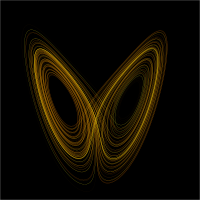
洛伦茨吸引子(Lorenz attractor)是洛伦茨振子(Lorenz oscillator)的长期行为对应的分形结构,以爱德华·诺顿·洛伦茨(Edward Norton Lorenz)的姓氏命名。洛伦茨振子是能产生混沌流的三维动力系统,又称作洛伦茨系统(Lorenz system),其一组混沌解称作洛伦茨吸引子,以其双纽线形状而著称。映射展示出动力系统(三维系统的三个变量)的状态是如何以一种复杂且不重复的模式,随时间的推移而演变的。
简述
[编辑]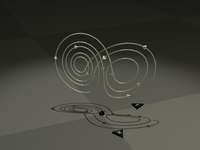
洛伦茨吸引子及其导出的方程组是由爱德华·诺顿·洛伦茨于1963年发表,最初是发表在《大气科学杂志》(Journal of the Atmospheric Sciences)杂志的论文《Deterministic Nonperiodic Flow》中提出的,是由大气方程中出现的对流卷方程简化得到的。
这一洛伦茨模型不只对非线性数学有重要性,对于气候和天气预报来说也有着重要的含义。行星和恒星大气可能会表现出多种不同的准周期状态,这些准周期状态虽然是完全确定的,但却容易发生突变,看起来似乎是随机变化的,而模型对此现象有明确的表述。
从技术角度看来,洛伦茨振子具有非线性、三维性和确定性。2001年,沃里克·塔克尔(Warwick Tucker)证明出在一组确定的参数下,系统会表现出混沌行为,显示出人们今天所知的奇异吸引子。这样的奇异吸引子是豪斯多夫维数在2与3之间的分形。彼得·格拉斯伯格(Peter Grassberger)已于1983年估算出豪斯多夫维数为2.06 ± 0.01,而关联维数为2.05 ± 0.01。
此系统也会出现在单模镭射[1]和发电机[2]的简化模型中。除此之外,闭环对流、水轮转动等物理模型也有此系统的应用。
洛伦茨方程
[编辑]
洛伦茨方程是基于纳维-斯托克斯方程、连续性方程和热传导方程简化得出,最初的形式为:
是流速,是流体温度,是上限温度(也可以写成),是密度,是压强,是重力,、、依次是热膨胀系数、热扩散率和动黏滞系数。
简化后的形式称为洛伦茨方程,是决定洛伦茨振子状态的方程为一组常微分方程:
含时间参数的形式:
称为普兰特尔数 ,称为瑞利数。所有的,, > 0,但通常 = 10, = 8/3,不定。若,则吸引子为原点,没有任何其他稳定点。1≤ρ<13.927时,螺线轨迹接近两点(这相当于存在阻尼振子),两点的位置由下列式子决定:、、。系统在 = 28时表现出混沌特性,但为其他值时会显示出具纽结的周期轨道。例如,当时,图像变为一个T(3,2)环面纽结。
初始条件的敏感依赖性 时间t=1 (放大) 时间t=2 (放大) 时间t=3 (放大) 
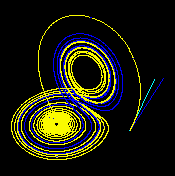
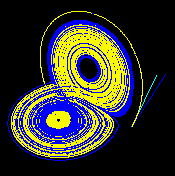
这三幅图是在ρ=28,σ = 10,β = 8/3的条件下生成的,展示出洛伦茨吸引子中的两条轨迹(蓝色、黄色各一)的三维演变的三个时段, 这两条轨迹的初始点只在x坐标上相差10-5。开始时,两条轨迹似乎是重合的(蓝色轨迹被黄色遮盖,因此只能看到黄色轨迹),但一段时间后,分离就变得明显了。 洛伦茨吸引子的Java动画展示了振子状态连续不断的演变 Portuguese Web Archive的存档,存档日期2008-03-11
瑞利数
[编辑]
不同ρ值时的洛伦茨吸引子 
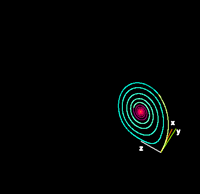
ρ=14, σ=10, β=8/3 (放大) ρ=13, σ=10, β=8/3 (放大) 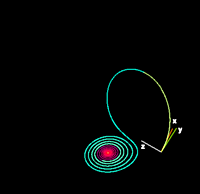

ρ=15, σ=10, β=8/3 (放大) ρ=28, σ=10, β=8/3 (放大) ρ值较小时,系统是稳定的,并能演变为两个定点吸引子中的一个;当ρ大于24.74时,定点变成了排斥子,会以非常复杂的方式排斥轨迹,演变时自身从不交叉。 显示不同ρ值时振子状态演变的Java动画 Portuguese Web Archive的存档,存档日期2008-03-11
源代码
[编辑]GNU Octave
[编辑]下面是GNU Octave模拟洛伦茨吸引子的源代码:
## Lorenz Attractor equations solved by ODE Solve
## x' = sigma*(y-x)
## y' = x*(rho - z) - y
## z' = x*y - beta*z
function dx = lorenzatt(X)
rho = 28; sigma = 10; beta = 8/3;
dx = zeros(3,1);
dx(1) = sigma*(X(2) - X(1));
dx(2) = X(1)*(rho - X(3)) - X(2);
dx(3) = X(1)*X(2) - beta*X(3);
return
end
## Using LSODE to solve the ODE system.
clear all
close all
lsode_options("absolute tolerance",1e-3)
lsode_options("relative tolerance",1e-4)
t = linspace(0,25,1e3); X0 = [0,1,1.05];
[X,T,MSG]=lsode(@lorenzatt,X0,t);
T
MSG
plot3(X(:,1),X(:,2),X(:,3))
view(45,45)
Borland C
[编辑]#include <graphics.h>
#include <conio.h>
void main()
{
double x = 3.051522, y = 1.582542, z = 15.62388, x1, y1, z1;
double dt = 0.0001;
int a = 5, b = 15, c = 1;
int gd=DETECT, gm;
initgraph(&gd, &gm, "C:\\BORLANDC\\BGI");
do {
x1 = x + a*(-x+y)*dt;
y1 = y + (b*x-y-z*x)*dt;
z1 = z + (-c*z+x*y)*dt;
x = x1; y = y1; z = z1;
putpixel((int)(19.3*(y - x*0.292893) + 320),
(int)(-11*(z + x*0.292893) + 392), 9);
} while (!kbhit());
closegraph();
}
Borland Pascal
[编辑]Program Lorenz;
Uses CRT, Graph;
Const
x: Real = 3.051522;
y: Real = 1.582542;
z: Real = 15.62388;
dt = 0.0001;
a = 5;
b = 15;
c = 1;
Var
gd, gm: Integer;
x1, y1, z1: Real;
Begin
gd:=Detect;
InitGraph(gd, gm, 'c:\bp\bgi');
While not KeyPressed Do Begin
x1 := x + a*(-x+y)*dt;
y1 := y + (b*x-y-z*x)*dt;
z1 := z + (-c*z+x*y)*dt;
x := x1;
y := y1;
z := z1;
PutPixel(Round(19.3*(y - x*0.292893) + 320),
Round(-11*(z + x*0.292893) + 392), 9);
End;
CloseGraph;
ReadKey;
End.
Fortran
[编辑]program LorenzSystem
real,parameter::sigma=10
real,parameter::r=28
real,parameter::b=2.666666
real,parameter::dt=.01
integer,parameter::n=1000
real x,y,z
open(1,file='result.txt',form='formatted',status='replace',action='write')
x=10.;y=10.;z=10.
do i=1,n,1
x1=x+sigma*(y-x)*dt
y1=y+(r*x-x*z-y)*dt
z1=z+(x*y-b*z)*dt
x=x1
y=y1
z=z1
write(1,*)x,y,z
enddo
print *,'Done'
close(1)
end program LorenzSystem
QBASIC/FreeBASIC("fbc -lang qb")
[编辑]DIM x, y, z, dt, x1, y1, z1 AS SINGLE
DIM a, b, c AS INTEGER
x = 3.051522: y = 1.582542: z = 15.62388: dt = 0.0001
a = 5: b = 15: c = 1
SCREEN 12
PRINT "Press Esc to quit"
WHILE INKEY$ <> CHR$(27)
x1 = x + a * (-x + y) * dt
y1 = y + (b * x - y - z * x) * dt
z1 = z + (-c * z + x * y) * dt
x = x1
y = y1
z = z1
PSET ((19.3 * (y - x * .292893) + 300), (-11 * (z + x * .292893) + 360)), 9
WEND
END
参见
[编辑]- 混沌映射列表
- Takens定理
- 曼德布洛特集合
参考文献
[编辑]- ^ (英文)Haken, H. Analogy between higher instabilities in fluids and lasers. Physics Letters A. 1975, 53 (1): 77–78. doi:10.1016/0375-9601(75)90353-9.
- ^ (英文)Knobloch, Edgar. Chaos in the segmented disc dynamo. Physics Letters A. 1981, 82 (9): 439–440. doi:10.1016/0375-9601(81)90274-7.
- (英文)Jonas Bergman, Knots in the Lorentz Equation[永久失效链接], 学士毕业论文, Uppsala University 2004.
- (英文)Frøyland, J., Alfsen, K. H. Lyapunov-exponent spectra for the Lorenz model. Phys. Rev. A. 1984, 29: 2928–2931. doi:10.1103/PhysRevA.29.2928.
- (英文)P. Grassberger and I. Procaccia. Measuring the strangeness of strange attractors. Physica D. 1983, 9: 189–208 [2022-01-08]. doi:10.1016/0167-2789(83)90298-1. (原始内容存档于2016-02-17).
- (英文)Lorenz, E. N. Deterministic nonperiodic flow. J. Atmos. Sci. 1963, 20: 130–141. doi:10.1175/1520-0469(1963)020<0130:DNF>2.0.CO;2.
- (英文)Strogatz, Steven H. Nonlinear Systems and Chaos. Perseus publishing. 1994.
- (英文)Tucker, W. A Rigorous ODE Solver and Smale's 14th Problem. Found. Comp. Math. 2002, 2: 53–117 [2010-02-26]. (原始内容存档于2019-12-28).
外部链接
[编辑]- (英文)埃里克·韦斯坦因. 洛伦茨吸引子. MathWorld.
- (英文)洛伦茨吸引子 (页面存档备份,存于互联网档案馆),作者为Wolfram Demonstrations Project的Rob Morris
- (英文)洛伦茨吸引子,planetmath.org
- (英文)用于绘出洛伦茨吸引子或处理类似情况的源代码 (页面存档备份,存于互联网档案馆),使用ANSI C及gnuplot实现
- (英文)《同步混沌与私人通信》,由MIT林肯实验室的Steven Strogatz与Kevin Cuomo讲解电子电路中洛伦茨吸引子的实现
- (英文)洛伦茨吸引子交互式动画 (页面存档备份,存于互联网档案馆)(需Adobe Shockwave插件)
- (英文)Levitated.net:计算艺术与设计 (页面存档备份,存于互联网档案馆)
- (英文)3D Attractors:三维方式显示和研究洛伦茨吸引子Mac程序
- (英文)3D VRML Lorenz attractor(需VRML浏览器插件)
- (英文)J语言实现洛伦茨吸引子演示的短文 (页面存档备份,存于互联网档案馆) - 见J语言
- (英文)非线性模拟的Java小程序 (页面存档备份,存于互联网档案馆)(选择预设“Lorenz attractor”),作者Viktor Bachraty,编写语言Jython
- (英文)模拟电子技术中洛伦茨吸引子的实现
- (简体中文)混沌蝴蝶——洛伦兹吸引子 (页面存档备份,存于互联网档案馆)
Text is available under the CC BY-SA 4.0 license; additional terms may apply.
Images, videos and audio are available under their respective licenses.

























